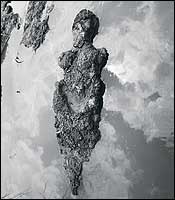
During a performance in 1972, Ana Mendieta (1948–1985) held a decapitated chicken by the legs as it fluttered messily toward death, spewing blood over her naked body. Untitled (Death of a Chicken) wasn’t a very successful work—jokes about Frank Perdue come too readily to mind—but it clarifies the underlying intentions of this artist particularly well. Mendieta is one of the modern tribe of writers, artists, and musicians who long for the spiritual power of ancient cultures, with their rituals of blood sacrifice, mortification of the body, and celebration of the earth mother. But she stands apart from the crowd because her dreaming does not seem abstract, as if it were fashioned in the seminar room. Nor is she becalmed by New Age niceties. Mendieta summons the ancients without flinching: She wants to feel the spray of blood on her skin.
Organized by Olga M. Viso for the Hirshhorn Museum and Sculpture Garden, Ana Mendieta: Earth Body—which recently opened at the Whitney Museum of American Art—contains about 100 works created by the artist during her brief life. A Cuban who came to the United States at the age of 12, Mendieta felt her exile keenly, and her desire to recover what’s buried in Western culture probably stemmed in part from her personal loss of country and place. (She longed for Cuba all her life, and she embraced Mexico.) As a young American artist, Mendieta steeped herself in the enthusiasms of the seventies. She was attracted to performance, body, and earth art. Feminist ideas and the growing Western interest in the Third World influenced her. Rather than paint the nude, as a male artist would, Mendieta became the nude, using her own body as the surface upon which to make her art. Some of her early work has a feminist edge. In Untitled (Rape Scene), she made images of a bloody, abused, and vulnerable female body.
“She summons the ancients without flinching. She wants to feel the spray of blood on her skin.”
But Mendieta soon developed an idiosyncratic style that’s not particularly beholden to the “isms” of the time. She seemed to want to fuse with the earth. In contrast to some of her male contemporaries, who were also working directly with nature, Mendieta did not aggressively shape or add to her environment. Instead, she united with what was there—water, earth, fire. In one early filmed performance, she lay in a flowing creek until her body almost became part of the stream bed. In other pieces, she printed her shape onto the ground, sometimes so subtly that you could miss the silhouette if you didn’t know where to look. She became a flower bed, and she drew her outline in fire. Often, her body had a somewhat ungainly or forgetful aspect, as if the Western nude no longer found it necessary to strike a pose. Almost always, in one way or another, she evoked burial, death, and sacrifice. Sometimes, the mortal intimations were just a gentle murmuring, as if death were nothing more than a yielding to natural forces. At other times, however, Mendieta created a kind of Aztec-Catholic shriek. In one sacrificial work, she lay shrouded in a white sheet drizzled in blood, with a large animal heart resting upon her chest.
Unfortunately, Mendieta’s death—the sculptor Carl Andre was acquitted of the crime of pushing her from a 34th-floor window—has cast a tabloid shadow over her oeuvre. Mendieta was a theatrical artist, but there was nothing cheap about her longing to transcend the body. She seemed haunted, not just intrigued, by what’s missing from Western society. It is her restless intensity, more than any particular work of art, that haunts us in turn. In a piece called Ánima, Silueta de Cohetes (Soul, Silhouette of Fireworks), a film of which is on view in the exhibition, she created a bamboo outline of her body and attached fireworks to this armature. At night, the effigy burst riotously into flame and then slowly subsided and burned down until only embers remained. The moment when those embers wink out, too, is poignant. Mendieta, even as she dreams of glorious renewal, remembers the dark.